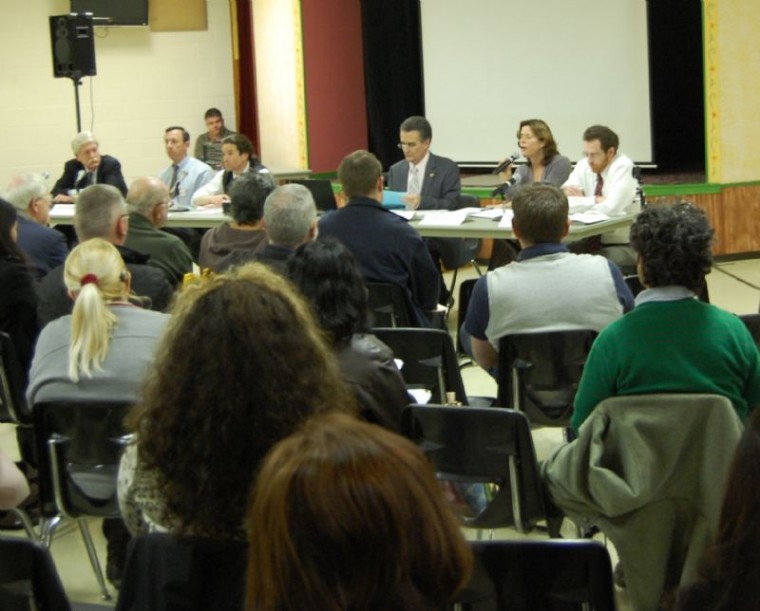Featuring laughter, applause, groans and furious trembling,
Tuesday night’s high-speed rail community meeting spanned a full
spectrum of emotions for the roughly 85 residents who braved the
rainy conditions Tuesday night to reach the San Martin Lions
Club.
Featuring laughter, applause, groans and furious trembling, Tuesday night’s high-speed rail community meeting spanned a full spectrum of emotions for the roughly 85 residents who braved the rainy conditions Tuesday night to reach the San Martin Lions Club.
A lively, sometimes testy, question-and-answer session highlighted the California High-Speed Rail Authority meeting, hosted by Mike Wasserman, Santa Clara County District 1 supervisor.
“The questions are getting more specific,” he said. “All the answers aren’t known, and I think that scares all of us.”
Wasserman often played the role of moderator between CHSRA officials and residents, including some who loudly interjected when they felt certain questions weren’t appropriately addressed.
Residents appeared to head home with some queries – the true cost of the project and just how many jobs it would create – left unsatisfied.
“There’s going to be some things that don’t match up right now,” Wasserman said.
The project’s $42.6 million price tag was called into question more than once.
One woman shook with anger as she told rail officials, “it’s going to be more money than you told us.”
She then asked the crowd, “How many of you want to be robbed this way?” and not a single hand was raised.
“No votes,” the woman sternly said.
Another man asked if the rail authority would conduct surveys of South County and unincorporated residents if they would ride the new train system once it’s built.
Gary Kennerley, regional manager for the project’s San Jose to Merced section, said, “We have no plans to do that,” as statewide and regional ridership studies were completed in 2005 by a rail-hired consultant.
San Martin resident John Sanders said those studies had been called into question and weren’t completely trustworthy.
Gilroy City Councilman Dion Bracco asked how fast and how frequently trains would pass through Gilroy.
Kennerley said limited-stop express trains passing through, and not in, Downtown Gilroy would reach a maximum of 185 mph and trains passing through east of town could reach 220 mph.
At peak hours, roughly eight to 10 trains in each direction per hour would pass through, Kennerley said.
Kennerley also said the draft environmental impact report was slated to come out in early 2012, with the final version being released later that year. Construction on the Central San Joaquin Valley section of the project could begin as early as 2013, he said.
Responding to another question, Kennerley said train cars would either have to be purchased from a foreign country and shipped to California, or the CHSRA would have to entice companies who build them to open shop within the state.
The issue of potential noise pollution also may soon be addressed, officials said.
A high-speed rail sound expert is expected to be on hand for two more community meetings in Gilroy and Morgan Hill next week.
The Gilroy meeting will be held at 6 p.m. Tuesday at Gilroy High School, and the Morgan Hill meeting will take place at 6 p.m. the following night at the Community & Cultural Center.
When asked if the rail authority would also bring sound samples to allow residents to compare the proposed train’s noise level to other vehicles, Kennerley said, “We don’t have official recordings at this time,” and doubted the authority would by next week.
Also made available Tuesday night was a four-page letter from Neelima Palacherla, executive director for Local Agency Formation Commission (LAFCO) of Santa Clara County, regarding the proposed east-of-Gilroy rail station. Her letter maintains that an east station location would be contrary to LAFCO’s key objectives of preserving agriculture and open-space land, and would conflict with state law requiring LAFCO to guide development away from prime agricultural lands. Wasserman said the station, for now, would still be a part of a $150,000 Valley Transportation Authority-funded station-visioning project in Gilroy. Wasserman however, read a statement from county legal counsel stating an east station “could be difficult to get past LAFCO.”
Attorney and eminent domain specialist Bradley Matteoni asked which audience members were afraid of losing some or all of their property to the rail project. About three-fourths of the residents shot their hands skyward.
Legally, residents whose land might be claimed by the project or those who are affected by road closures or noise because of the project likely would be compensated financially, Matteoni said. Those who refuse the authority’s offers likely would end up fighting that portion of the project in court, she said.
“I can’t stop the project,” Matteoni said. “The high-speed rail cannot be designed for one property owner.”










